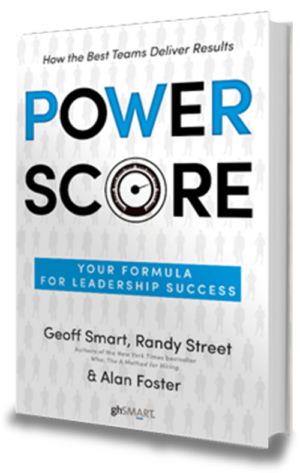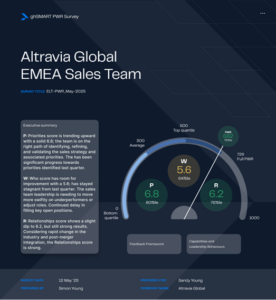A Decade of Power Score: What Still Works and What’s Next
July 3, 2025 | Team Insight
We interviewed authors Geoff Smart, Randy Street, and Alan Foster to explore what’s changed, what still holds true, and where the PWR framework goes from here.
What if there were a leadership formula 20x more likely to drive success? That’s what the authors of Power Score uncovered when they analyzed what makes leaders successful. Published in 2015, the book introduced a simple but powerful formula — P × W × R — demonstrating that when leaders set the right Priorities, hire the right “Who”, and build strong team Relationships, they unlock extraordinary results.
A decade later, even as the business landscape has been transformed by AI and accelerated change, the Power Score framework still delivers. What’s kept it relevant isn’t just its simplicity, but its versatility. “We didn’t go into the project with a model in mind,” said co-author and ghSMART Founder & Chairman Geoff Smart. “We asked the question: what leads to high-performing teams? The model emerged from the data, and it turned out to be more useful than we expected.”
Why P x W x R Has Held Up
Over the past ten years, the framework has proven useful in real-world applications with executives, investors, and boards. Geoff Smart recalls, “It could’ve been academically accurate but not practically useful. Instead, it’s become a go-to for first conversations with clients and a framework we use years into deep engagements. It helps leaders cut through noise.”
One reason the framework endures is that each component of the Power Score, P, W, and R, is clearly defined and independent. “They don’t overlap,” said Smart. “Priorities are what you focus on. The Who is about your people. And Relationships map the influence and alignment dynamics.”
At ghSMART, P × W × R has become the gold standard for how we partner with leaders. It’s a foundational framework across client solutions, including executive coaching, C-suite onboarding, board and team effectiveness, next-gen development, and CEO and C-suite succession.
Across hundreds of client engagements, the authors have seen time and again how the framework simplifies complexity. “It classifies every leadership challenge into three buckets,” said co-author, ghSMART Senior Advisor and WhoAi CEO Randy Street. “And it’s held up shockingly well.”
Client feedback continues to affirm the value of the PWR framework. As one executive put it, “The PWR framework for top-tier performance is exceptional.” A Managing Partner echoed the sentiment: “The PWR score work is the best I’ve seen in my career.”
The Private Equity Lens: Speed and Precision
Alan Foster’s work with private equity clients has validated the Power Score model under high-pressure conditions. Earlier this year, he analyzed more than 200 private equity-backed CEO assessments, ranging from top performers who achieved extraordinary exits, to those who ended in bankruptcy. His conclusion: “Full PWR leaders generated higher returns for their investors; Power Score holds.”
Key findings from the recent analysis:
• The best PE CEOs are 2x more likely to be strong at setting the right Priorities.
• Top PE CEOs address B-players 1.3x faster than their less effective peers.
• CEOs who build strong Relationships are 2x more likely to succeed.
What sets these leaders apart? “Speed,” Foster explained. “They quickly engage in a short, targeted, strategic phase, often within the first few weeks post-close. They’re fast to evaluate who needs to stay, who needs to go, and where they need to hire. They don’t wait for perfect information; they start generating momentum.”
Equally important is how they relate to people. A high-functioning portfolio CEO builds strong, transparent relationships with both their team and their investors. “They’re confident but not arrogant. Curious but not defensive. That balance builds trust in high-stakes environments.”
These findings reinforce what Foster and his co-authors have seen across client engagements: the Power Score framework continues to map closely to the leadership behaviors that drive results, especially when the stakes are highest.
A Framework for Rapid Change
If anything has tested the durability of Power Score, it’s the last few years of volatility and disruption, especially with AI. Leaders and teams are having to operate differently than they ever have before, inventing the playbook as they go. Yet, these challenges have amplified the utility of the framework.
Street sees AI as a force multiplier. “AI helps leaders become 10X more effective, as long as they know how to use it productively,” he said. “Use it to refine your priorities. Use it to coach your team. Use it to hire better, faster. Power Score helps guide where and how to apply those tools.”
Foster adds that it supports leadership during times of uncertainty as well. He told the story of a CEO who took over a UK public company just as COVID hit. While this leader had never met his team in person, he was still able to lead a strategic pivot, upgrade half the leadership team, and double the company’s value in two years. “He executed on P, W, and R brilliantly, in chaos.”
Looking Ahead: The Next Chapter
So, what’s next for Power Score? Smart envisions dashboards powered by AI that show real-time PWR scores for every team in a company, helping leaders identify where to focus. “Picture being able to double click and see: this team is struggling with P, or that one needs a W upgrade. It’s targeted, actionable leadership.” ghSMART is actively developing digital solutions to turn that vision into reality.

Illustrative example. Source: ghSMART
“Imagine if we could quantify how moving a team’s PWR score from 400 to 600 increases company value by $2 billion,” said Smart. “That’s where we’re headed.”
And while the model remains simple, its implications are profound. “PWR gives you clarity,” said Street. “And in a world that’s only getting noisier, that’s the most valuable thing a leader can have.”
— — —
